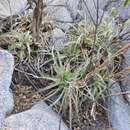Comprehensive Description
provided by North American Flora
Hechtia montana Brand. Erythea 7: 9. 1899
Hechlia pedicdlala "S. Wats." I. M. Johnston, Proc. Calif. Acad. IV. 12: 995. 1924.
Plant imperfectly known, probably about 1 m. high; leaves numerous in a dense rosette, 15-45 cm. long; sheaths large, broadly ovate to suborbicular, brown, glabrous or obscurely punctulate; blades linear-triangular, pungent, 2-3 cm. wide, cinereous-scurfy below, appressedIcpidote and soon glabrous and shiny above, armed with slender uncinate brown teeth up to 5 mm. long and 10-25 mm. apart; scape terete, 1 era. in diameter, sparsely floccose-lepidote, soon glabrous; scape-bracts strict, the lower ones foliaceous, 10-15 cm. long, imbricate, the upper linear-lanceolate, pungent, remote; inflorescence laxly bipinnate, slenderly pyramidal, 3-5 dm. long, sparsely white-floccose, soon glabrous; primary bracts lance-ovate, acuminate, much shorter than the axillary branches, sparsely serrate or entire; racemes sessile or subsessile, ascending or spreading, laxly flowered especially in the pistillate plants, up to 16 cm. long; floral bracts linear-lanceolate, acuminate, equaling or exceeding the staminate pedicels, about half as long as the pistillate pedicels, flowers spreading; pedicels slender, the staminate 2-3 mm. long, the pistillate 4—8 mm. long; staminate sepals broadly ovate, acute, 2.5 mm. long, thin; pistillate sepals narrowly deltoid, acuminate, 3 mm. long, much thickened at base and bearing 3 prominent nerves; staminate petals broadly elliptic, obtuse, 4.5 mm. long, pale-yellow; pistillate petals deltoid, acuminate, 5 mm. long; stamens included; ovary slightly inferior; stigmas sessile; capsule ovoid, acute, 1 cm. long; seeds oblong or falcate with a narrow dorsal wing which is prolonged at apex into a narrow appendage nearly as long as the seed.
Type locality: Along the base of the mountains, San Jos6 del Cabo, [Baja California]. Distribution: Southern Baja California, Sonera, and Sinaloa.
- bibliographic citation
- Lyman Bradford Smith. 1938. (XYRIDALES); BROMELIACEAE. North American flora. vol 19(2). New York Botanical Garden, New York, NY
Hechtia montana: Brief Summary
provided by wikipedia EN
Hechtia montana is a species of plant in the genus Hechtia. This species is endemic to Mexico.
The Latin specific epithet montana refers to mountains or coming from mountains.
The plant is used as a traditional food source in Sonora, Mexico; the Guarijío call it hichiconi and roast the rosettes, eating them much like an artichoke, while the Tarahumara are said to give it the name chikani and eat the leaves raw year-round.
- license
- cc-by-sa-3.0
- copyright
- Wikipedia authors and editors

